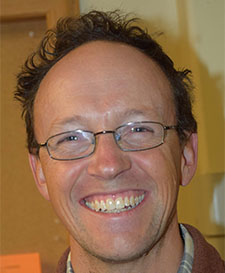
PROFESSOR
Wyoming Excellence Chair
Paleohydrology, Paleoclimatology, Paleoecology
Office Phone: (307) 766-6442
Dept. #3006
1000 E. University Ave.
Laramie, Wyoming 82071-3006 Office Room No: ESB 2010
Email: bshuman@uwyo.edu
Education
Geological Sciences, PhD, Brown University, 2001
Geological Sciences, MS, Brown University, 1997
Geology, BA, Colorado College, 1994
teaching statement
My training has been interdisciplinary, linking climatology and ecology with geology, and I have enjoyed teaching classes that span a wide range of environmental systems. Having attended Colorado College and Brown University, where undergraduate education was emphasized, I see its value and am committed to excellent undergraduate instruction. I also seek to be a dedicated advisor for graduate students. I am excited to organize seminars and courses with the aim of developing new ideas and advancing research, as well as teaching fundamental concepts about Earth System science, environmental change, and the scientific process.
In addition to training a diverse group of students, my research is integrated into a unique educational-outreach project focused on environmental change along the Continental Divide National Scenic Trail.
courses taught
- GEOL 1070 - Earth: Its Physical Environment
- GEOL 2100 - Stratigraphy and Sedimentology
- GEOL 3500 - Global Change: A Geological Perspective
- GEOL 5200 - Paleoclimatology
current graduate students
- John Calder - PhD Candidate
- Grace Carter - PhD Candidate
- Jeremiah Marsicek - MS Candidate
- Marc Serravezza - PhD Candidate
research projects
Patterns and consequences of past climatic change: tracking the availability of water.
Water is a vital resource. Water affects vegetation, natural processes like wildfire, and human society. Availability of water, however, changes constantly because of climatic factors. Future conditions, like those of the past, will deviate from modern norms. Yet, we know little about the potential for change beyond that experienced in recent centuries. Ongoing work focuses on documenting and mapping changes in the levels of lakes throughout North America over the past 15,000 years. Through comparison with vegetation and fire history data, geochemical data, archeological data, and climate model simulations, the results demonstrate patterns of climatic variation and attendant impacts on landscapes and societies.
ongoing research projects
- Changing spatial patterns of Rocky Mountain snowpack during the Holocene and their effects on ecological boundaries.
- Sub-Millennial Hydroclimatic Variability in the Northeastern U.S. during the Holocene.
- Comparing the Effects of Holocene and 20th Century Drought on Minnesota's Lakes
- Effects of fire and climate on the vegetation history of the Big Woods of Minnesota.
- Surface-Atmosphere Feedbacks and Holocene Climate Variations in Eastern North America: Linkages, Impacts, and Governing Mechanisms.
recent publications
Stefanescu, I. C., Shuman, B. N., Grigg, L. D., Bailey, A., Stefanova, V., & Oswald, W. W. (2023). Weak precipitation δ2H response to large Holocene hydroclimate changes in eastern North America. Quaternary Science Reviews, 304, 107990.
Parish, M. C., Wolf, K. D., Higuera, P. E., & Shuman, B. N. (2022). Holocene water levels of Silver Lake, Montana, and the hydroclimate history of the Inland Northwest. Quaternary Research, 1-13. https://doi.org/10.1017/qua.2022.17
Liefert, D. T., & Shuman, B. N. (2022). Expression of the “4.2 ka event” in the southern Rocky Mountains, USA. Climate of the Past, 18(5), 1109-1124. https://doi.org/10.5194/cp-18-1109-2022
Higuera, P. E., Shuman, B. N., and Wolf, K. D. (2021) Rocky Mountain forests are burning now more than anytime in recent millennia. Proceedings of the National Academy of Sciences 118 (25), e2103135118. https://doi.org/10.1073/pnas.2103135118
Hostetler, S., C. Whitlock, B. Shuman, D. Liefert C. Drimal, S. Bischke. (2021). Greater Yellowstone climate assessment: past, present, and future climate change in greater Yellowstone watersheds. Bozeman MT: Montana State University, Institute on Ecosystems. 260 pp. https://doi.org/10.15788/GYCA2021. (https://gyclimate.org/)

